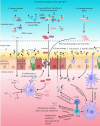The dark side of the gut: Virome-host interactions in intestinal homeostasis and disease
- PMID: 33760921
- PMCID: PMC8006857
- DOI: 10.1084/jem.20201044
The dark side of the gut: Virome-host interactions in intestinal homeostasis and disease
Abstract
The diverse enteric viral communities that infect microbes and the animal host collectively constitute the gut virome. Although recent advances in sequencing and analysis of metaviromes have revealed the complexity of the virome and facilitated discovery of new viruses, our understanding of the enteric virome is still incomplete. Recent studies have uncovered how virome-host interactions can contribute to beneficial or detrimental outcomes for the host. Understanding the complex interactions between enteric viruses and the intestinal immune system is a prerequisite for elucidating their role in intestinal diseases. In this review, we provide an overview of the enteric virome composition and summarize recent findings about how enteric viruses are sensed by and, in turn, modulate host immune responses during homeostasis and disease.
© 2021 Li et al.
Conflict of interest statement
Disclosures: The authors declare no competing interests exist.
Figures


Similar articles
-
Gut inflammation and immunity: what is the role of the human gut virome?Mediators Inflamm. 2015;2015:326032. doi: 10.1155/2015/326032. Epub 2015 Apr 7. Mediators Inflamm. 2015. PMID: 25944980 Free PMC article. Review.
-
The Intestinal Virome and Immunity.J Immunol. 2018 Sep 15;201(6):1615-1624. doi: 10.4049/jimmunol.1800631. J Immunol. 2018. PMID: 30181300 Free PMC article. Review.
-
Virome-host interactions in intestinal health and disease.Curr Opin Virol. 2019 Aug;37:63-71. doi: 10.1016/j.coviro.2019.06.003. Epub 2019 Jul 8. Curr Opin Virol. 2019. PMID: 31295677 Review.
-
Regulation of host/pathogen interactions in the gastrointestinal tract by type I and III interferons.Curr Opin Immunol. 2024 Apr;87:102425. doi: 10.1016/j.coi.2024.102425. Epub 2024 May 18. Curr Opin Immunol. 2024. PMID: 38763032 Free PMC article. Review.
-
Does the Human Gut Virome Contribute to Host Health or Disease?Viruses. 2023 Nov 17;15(11):2271. doi: 10.3390/v15112271. Viruses. 2023. PMID: 38005947 Free PMC article. Review.
Cited by
-
The human gut virome: composition, colonization, interactions, and impacts on human health.Front Microbiol. 2023 May 24;14:963173. doi: 10.3389/fmicb.2023.963173. eCollection 2023. Front Microbiol. 2023. PMID: 37293229 Free PMC article. Review.
-
Imbalance of the intestinal virome and altered viral-bacterial interactions caused by a conditional deletion of the vitamin D receptor.Gut Microbes. 2021 Jan-Dec;13(1):1957408. doi: 10.1080/19490976.2021.1957408. Gut Microbes. 2021. PMID: 34375154 Free PMC article.
-
Microbiota and COVID-19: Long-term and complex influencing factors.Front Microbiol. 2022 Aug 12;13:963488. doi: 10.3389/fmicb.2022.963488. eCollection 2022. Front Microbiol. 2022. PMID: 36033885 Free PMC article. Review.
-
Assessing Bias and Reproducibility of Viral Metagenomics Methods for the Combined Detection of Faecal RNA and DNA Viruses.Viruses. 2025 Jan 23;17(2):155. doi: 10.3390/v17020155. Viruses. 2025. PMID: 40006910 Free PMC article.
-
Phage therapy: Targeting intestinal bacterial microbiota for the treatment of liver diseases.JHEP Rep. 2023 Sep 23;5(12):100909. doi: 10.1016/j.jhepr.2023.100909. eCollection 2023 Dec. JHEP Rep. 2023. PMID: 37965159 Free PMC article. Review.
References
-
- Abt, M.C., Buffie C.G., Sušac B., Becattini S., Carter R.A., Leiner I., Keith J.W., Artis D., Osborne L.C., and Pamer E.G.. 2016. TLR-7 activation enhances IL-22-mediated colonization resistance against vancomycin-resistant enterococcus. Sci. Transl. Med. 8:327ra25. 10.1126/scitranslmed.aad6663 - DOI - PMC - PubMed
-
- Aiyegbo, M.S., Sapparapu G., Spiller B.W., Eli I.M., Williams D.R., Kim R., Lee D.E., Liu T., Li S., Woods V.L. Jr., et al. . 2013. Human rotavirus VP6-specific antibodies mediate intracellular neutralization by binding to a quaternary structure in the transcriptional pore. PLoS One. 8:e61101. 10.1371/journal.pone.0061101 - DOI - PMC - PubMed
Publication types
MeSH terms
Grants and funding
LinkOut - more resources
Full Text Sources
Other Literature Sources
Medical

